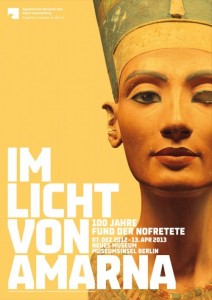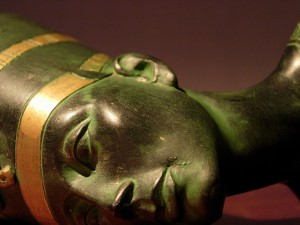As the warm days of June approach the city of Berlin, the Die Bärliner summer team will be taking more and more trips to exhibitions, festivals, and other events happening this summer in the realms of our beautiful and exciting city. The first in the series of my summer articles about the city of Berlin is on an exhibition in the Neues Museum, In the Light of Amarna: 100 Years of the Nefertiti Discovery (7th December 2012 – 4th August 2013), which I warmly recommend to everyone even vaguely interested in archeology and ancient Egypt.

The special exhibition on the Amarna period, organized by the ‘Egyptian Museum and Papyrus Collection’ at the Neues Museum, located on the “Museum Insel”, marks the 100th anniversary of the discovery of the bust of Nefertiti on December 6, 1912. With approximately 400 objects from the period, including the borrowed artifacts from other museums such as the Metropolitan Museum of Art, the Louvre, and the British Museum, the exhibition places the time, in which Queen Nefertiti lived, within the historical context of the city of Amarna, the capital of ancient Egypt during Akhenaten’s rule, and celebrates the discovery of the famous bust during the excavations in 1912 and 1913, led by Ludwig Borchardt, a German Egyptologist from Berlin.
At the center of the Neues Museum archeological collection on ancient and modern Egyptian history, stands an embodied history––the bust of Nefertiti, the Great Royal Wife of pharaoh Akhenaten. My fascination with ancient Egypt and my interest in Nefertiti as a prominent female figure in its history has been part of my life ever since childhood. However, it was not until after I began researching the “New Kingdom” dynasty period for my final project as a high school senior last year, that I started to truly share the admiration for her legacy with a number of Egyptologists who made her history known and presentable to us here and now in Berlin. Who was this woman exactly of whose influence we still hear today and why are her bust and life story the central focus of the Egyptian collection at the Neues Museum?
Nefertiti was the royal woman of Amenhotep IV, better known as Akhenaten and the pharaoh who introduced the monotheistic religion of god Aten (thus the name AkhenAten). She was one of the most famous elite queens of the 18th dynasty and well known for her astonishing beauty. Ever since her time, she has represented an ideal of a beautiful face, still admired in the form of a bust by the thousands of visitors who come to the special chamber, which resembles a temple of worship within the Neues Museum.
Nefertiti’s power did not lie simply in her looks, but also in her self-confidence and inborn ability for leadership. Nefertiti was an uncommonly powerful queen, even the guiding force behind the throne. Scenes from Aten’s temple at Karnak and papyrus collections from the Neues Museum narrate of her active role in the religious and political life of the state. She lived with her husband Akhenaten in Amarna, the new capital he established for his monotheistic religion, with the Sun as the only deity. The city of Amarna bears many imprints of the past time of Nefertiti and Akhenanten’s rule, many left in their unfinished portraits and granite heads, some of which can be found either as an original or a reconstructed sample at the Amarna exhibition.

Seeing the artifacts of Nefertiti’s time, situated around her bust chamber, inclines one’s imagination to take a stroll down the memory lane, which is filled with vivid images of both the everyday life dishes and the exclusive royal jewels as symbols of status. The exhibition awoke the inner Egyptian in me too, and for a moment I felt like a resident of the extraordinarily artistically and archeologically rich Amarna period, infused with the spirit of Nefertiti in every statue, stele, and hieroglyph.
I remember being powerfully influenced by Nefertiti during the writing process of my paper on the grand women of the “New Kingdom” period last year. Many speculations were made throughout history on whether she in fact ruled side by side with Akhenaten. At the time I could find no substantial evidence or reference clearly indicating that in addition to her powerful role in society, Nefertiti was also formally recognized by her husband as a Queen Regent, or as an equal ruler by his side. Nonetheless, I have always had a strangely strong belief that such was indeed the case. Given the recent evidence from 2012, the Amarna exhibition, set in honor of Nefertiti, proved my intuition right.
The excavations in Amarna last year proved successful in affirming once and for all the importance of Nefertiti during the Akhenaten rule. The Amarna Egyptologists found a document, in which Akhenaten assigns Nefertiti as his co-regent and thereby equally shares the power and influence over the state with her. In the time when women could not be pharaohs, and men almost always held the leading positions, Nefertiti’s status represented a revolutionary turning point that proved women can be just as capable as men in state leadership.
Altogether, it is no wonder that Nefertiti is still highly popular in Egypt and worldwide. The exhibition shows a number of references to Nefertiti in popular culture, from statues to comic books. There are several excavated documents speaking of various names and descriptions for the Queen Regent: Great of Favor, Beloved One, Soothing the King’s Heart in His House, Soft-Spoken in All, Mistress of Upper and Lower Egypt, Great King’s Wife, Lady of the Two Lands and others. They are a testament of her popularity amongst the people and her importance for the nation, as they imply her position and political influence through the rule with her husband. Her legacy spread over the succeeding dynastic periods and ultimately reached contemporary times thanks to Borchardt’s excavations in 1912 and 1913. The beginning of the 20th century, therefore, brought Nefertiti back to life thanks to the discovery of her bust and the records of her untypically important, given the historical context, political role.
Nefertiti marked the “New Kingdom” period as the most beautiful and beloved Egyptian queen. In the Light of Amarna: 100 Years of the Nefertiti Discovery gives us, the mere spectators into the well of the times past, an opportunity to go back to the glorious days of the Amarna period and consider how one woman, despite the social norms and her gender, could climb the social ladder with her skill and honor, and always managed to astonish people with her strength, beauty, and unique aura––even thousands of years after her death.
